How to Incorporate Indoor Plants Into Your Home Décor
Transform your home with indoor plants. Discover beginner-friendly houseplants, styling tips, and décor ideas to create a vibrant, healthy space.
Bringing plants into your home isn’t just about adding a splash of green. It’s a way to make your space feel more stylish, comfy, and even healthier. Over the years I’ve found that green touches transform the mood of any room, making it feel more lived in and welcoming. Whether you’re looking to amp up your décor game or just want fresher air and a calmer home, successfully incorporating plants is totally doable with a few smart tips and a little inspiration.
Hello & welcome, my passion for interior styling began when we moved into our Georgian home and I set out to transform its plain walls into colourful, character-filled spaces. Over the years I’ve fallen in love with bold paint choices, thoughtful lighting, and accessories that highlight a home’s natural charm. Now I share simple, inspiring décor ideas to help others create rooms that feel warm, personal, and beautifully unique.
Garden Nest Living grew from a simple idea: to share my love of gardens and creating calm, beautiful spaces, both inside and out. When you buy through my affiliate links, you are allowing me to keep sharing inspiration, ideas and products… at no extra cost to you. Thank you for being a part of my journey!
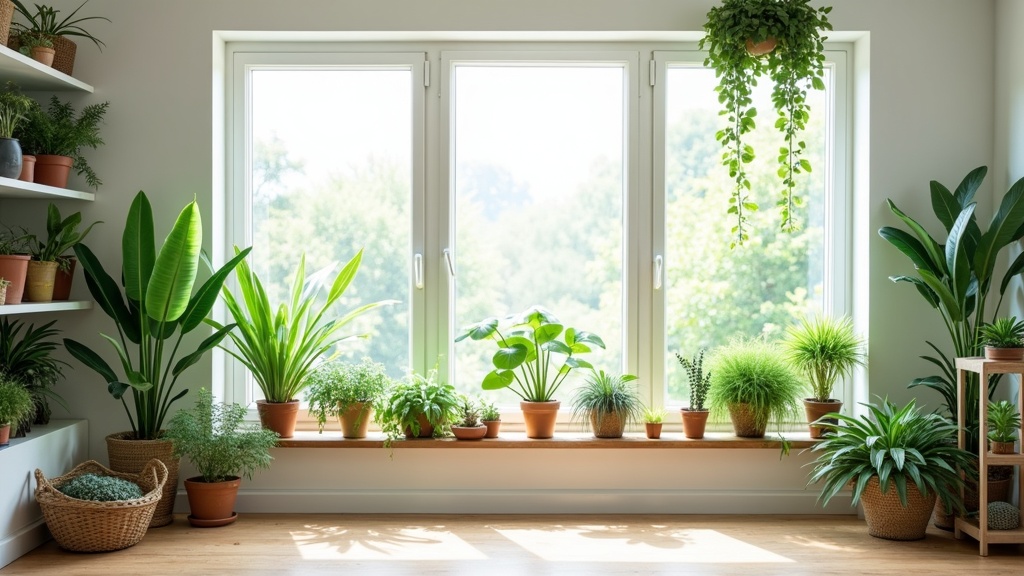
Why Add Indoor Plants to Your Home Décor?
Health, Style, and Wellbeing Benefits of Indoor Plants
Health Benefits of Indoor Plants (air purification, stress reduction, improved focus)
Indoor plants go way beyond aesthetics. NASA’s Clean Air Study found that houseplants aren’t just lovely to look at—they help clear the air of toxins like benzene and formaldehyde. Adding plants can make your home healthier and cosier at the same time. It’s pretty amazing how something as simple as a snake plant or peace lily can filter out the bad toxins. For me, stumbling upon this was one of the big reasons I started filling my shelves with greenery.
For clarity, this is personal experience, not professional, medical or health advice.
Style & Mood Enhancements (textures, greenery, vibrancy)
Different plants also bring different textures and vibes. Large leaf favourites such as monstera or fiddle leaf figs give a bold energy, while trailing vines like string of pearls soften hard surfaces, making rooms feel balanced and lively.
Wellbeing & Lifestyle Perks (calming energy, natural focal points)
Grouping a few plants together seems to turn up their impact. When I cluster three or five together on a table or shelf, it always draws the eye and adds a natural focal point.
Best Indoor Plants for Beginners and Beyond
Beginner-Friendly, Advanced, and Faux Plant Options
The first step in blending plants into your home decor is thinking about your lifestyle and space. Some of us love doting on high-maintenance tropicals, but if you’re like me, you probably need a few “set and forget” varieties too.
Beginner-Friendly Plants
- Snake plant, pothos, and ZZ plant pretty much thrive anywhere. These guys handle missed waterings and non-ideal lighting, making them super forgiving when life gets busy.
Advanced & Stylish Options
- Try myrtle topiary, rare ferns, or even a dramatic black olive tree for a real style upgrade. Ficus elastica (rubber plant) or ficus triangularis make bold statements too and like regular attention.
Hardy & Low-Maintenance Choices
- For cooler rooms or less sunny spots, hardy options like aspidistra or cast-iron plant are practically bulletproof.
Faux Plants as Alternatives
- Not ready for the real thing? Shop papier-mâché or silk plants. You still get a fresh vibe minus the watering can.
If you want to really boost your home’s air quality, check out options like peace lily, spider plant, and Boston fern—they’re known for cleaning indoor air.
From Faux to Fresh: How I Started My Indoor Plant Journey
When my husband gifted me my very first orchid, I was instantly captivated—but also a little nervous. I loved the idea of growing a collection of houseplants, yet I was worried about choosing the wrong ones or, worse, letting them die from neglect. To play it safe, I began buying artificial plants. Faux greenery gave me the look I wanted without the stress of plant care, but over time I realised something was missing—the freshness, vibrancy, and calming energy that only real, living plants can bring into a home.
That’s when I decided to take the leap. I started researching the best easy-care indoor plants for beginners, learning which varieties could thrive with minimal effort. Slowly, my confidence grew, and so did my collection. What began as one orchid soon blossomed into a thriving indoor jungle. Looking back, I’m so glad I made the switch from faux to fresh—because nothing compares to the beauty and atmosphere of real greenery in your home.
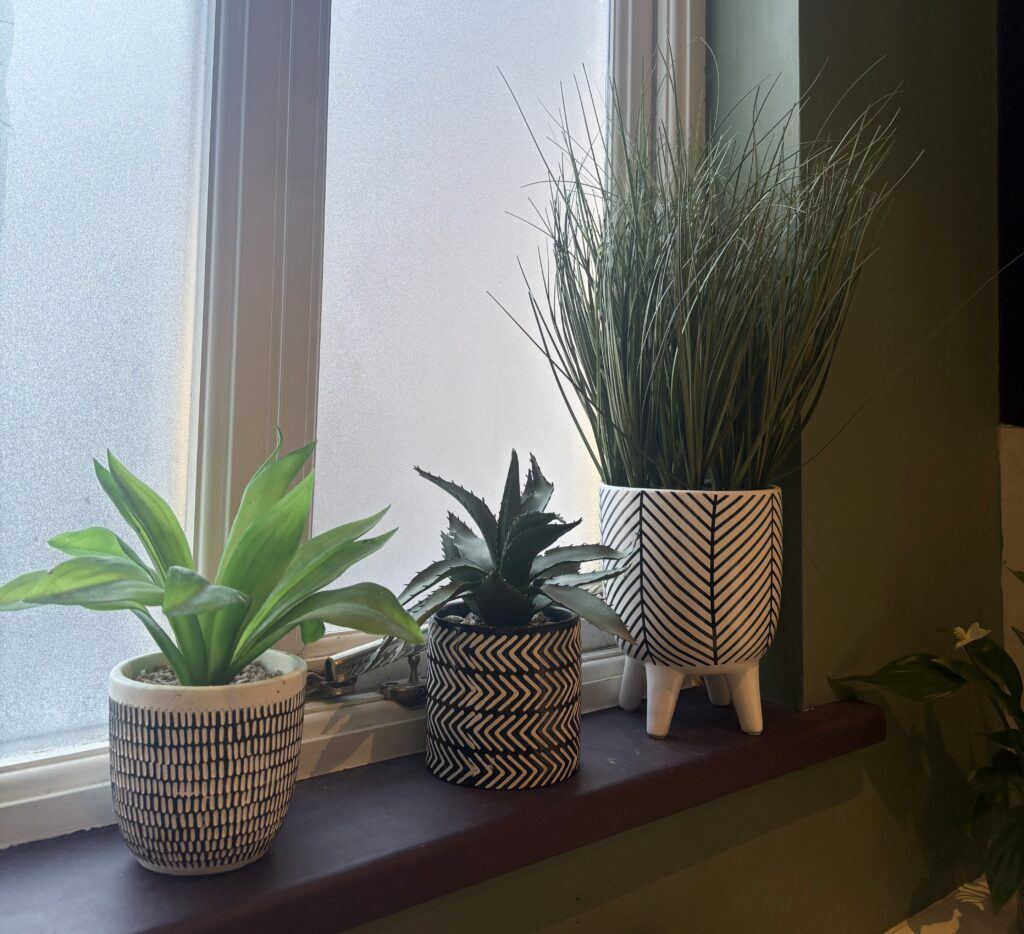
3 faux plants sitting on our bathroom windowsill.
Indoor Plant Styling Tips: How to Decorate with Houseplants
How to Decorate with Plants Like a Pro
Using plants effectively in your space takes a little planning. I’ve rounded up simple yet powerful tips I use whenever I want to mix it up in my home’s look:
Match Plants to Light Sources
My golden rule is “right plant, right place.” Most casualties happen because the wrong plant is placed in the wrong light setting. Low-light plants work for dim corners, but sun lovers need south-facing windows. Take notice of your room’s sun patterns before bringing anything home.
Grouping Plants for Visual Impact
Plants grouped in odd numbers (three is my go-to) with a mix of heights and leaf textures look way more natural than single pots scattered everywhere. I usually play around with arrangements until something feels balanced and interesting.
Choosing the Right Planters for Style
The pot matters. I swear by terracotta for warmth, metallics for a modern edge, and woven baskets for a relaxed boho vibe. Mixing textures by combining ceramics, baskets, and classic planters always adds depth to the space.
Using Vertical Space (hanging planters, shelves)
Hanging planters and wall-mounted plant shelves let you slip in greenery when floor space is tight. My kitchen got a total lift just by suspending three trailing plants by the window.
Always put saucers or trays under pots to protect surfaces, especially wooden shelves or floors. Check how thirsty a plant tends to be before picking the container size and style; I’ve learned this trick the hard way with soggy, root-bound disasters.
Seasonal Styling with Plants
Plants react to changing seasons just like we do. Paperwhites or amaryllis in winter make things brighter, while fresh branches or cherry blossoms bring immediate spring feels to any overlooked space, like a bathroom or guest bedroom.
Step-by-Step Indoor Plant Styling Guides
How to Group Plants for Impact in 3 Steps
Step 1: Choose an Odd Number
Always group plants in 3s or 5s. Odd numbers look more natural and eye-catching than even numbers.
Step 2: Mix Heights & Textures
Combine tall statement plants (like fiddle leaf figs), medium-sized fillers (like ferns), and trailing vines (like pothos).
This creates layers and depth, similar to how plants grow in nature.
Step 3: Anchor with a Focal Point
Pick one plant as the “star” (the tallest or boldest), and let the others support it.
Place them together on a side table, shelf, or clustered by a window for maximum effect.
Pro tip: Use planters in different finishes—like terracotta, ceramic, or baskets—to add even more texture.
Plant Pairings for Different Décor Styles
Boho Style
Plants: Monstera, palms, pothos, hanging string of pearls.
Planters: Woven baskets, macramé hangers, terracotta pots.
Effect: Relaxed, eclectic, and full of lush greenery.
Minimalist Style
Plants: Snake plant, ZZ plant, bird of paradise.
Planters: Sleek matte black, white, or concrete pots with clean lines.
Effect: Bold but simple, letting each plant stand out as sculpture-like décor.
Traditional Style
Plants: Orchids, ferns, African violets, ficus elastica (rubber plant).
Planters: Classic ceramic or blue-and-white porcelain.
Effect: Timeless elegance with plants that complement vintage or classic interiors.
Pro tip: Match plant forms with your furniture. Flowing vines soften sharp edges; upright plants emphasise symmetry.
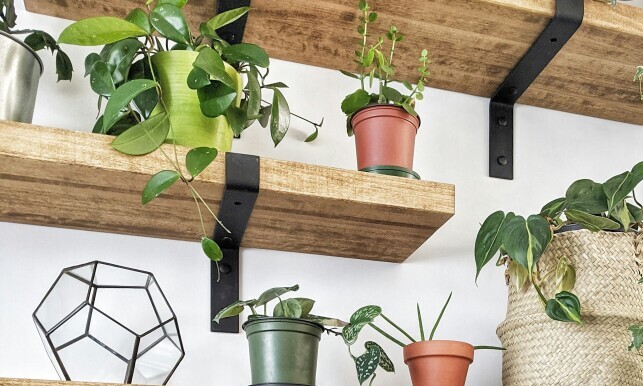
Advanced Plant Styling Ideas
Pro-Level Tips to Make Your Plant Décor Stand Out
If you want to really show off your design sense, try some of these pro-level plant styling ideas:
Symmetry for Traditional Spaces
- Twin orchids or palms on either side of a fireplace or entryway create a classic look in older homes.
Sculptural Plants for Modern Homes
- Leafy fiddle leaf figs or snake plants look eye-catching against minimalist backdrops.
- Combine soft leafy ferns with more upright sculptural varieties and let containers vary in material and finish.
Local Inspiration (choosing region-appropriate plants)
- Pick plants that fit your geography for a design that feels more organic. Delicate ferns feel right at home in cottages; bolder agaves and cacti fit modern city flats.
Herbs as Décor for Practical Beauty
- Kitchen windowsill filled with oregano, mint, or basil? That’s both pretty and practical for home cooking.
Plants are never static. I move mine around often to keep things fresh or to give them better sun as the seasons change. I also give myself permission to swap out or replace them if they look sad or if my style switches up. Not every plant will thrive forever, and that’s totally okay. Also, don’t overlook plant care tools and stylish watering cans—these can give a boost to your plant décor vibe and make care routines more enjoyable. Adding decorative plant stands can also raise smaller species so they don’t get lost among furniture, making each display more prominent.
Frequently Asked Questions About Indoor Plants
How do you display plants in the living room?
Answer: I like mixing floor-standing plants like monstera, small pots on shelves, and the occasional hanging planter near windows. Combining different heights, leaf shapes, and planter styles creates a dynamic look. Try clustering several plants on a coffee table or arranging them at different levels on a bookshelf. Bigger living rooms look awesome with a large fiddle leaf fig or palm as a natural centrepiece.
What are the best plants for a south-facing window in the UK?
Answer: South-facing windows get the most light, perfect for sun-loving plants. Succulents, cacti, jade plant, and olive trees love the bright exposure. If your window gets a little too hot in peak summer, adding sheer curtains helps prevent leaf scorch.
Which indoor plants are best for interior design?
Answer: Fiddle leaf fig, monstera, bird of paradise, and rubber plants all bring a strong design impact. For trailing interest, I use pothos or string of hearts. Styled in stylish pots or grouped together, these plants add shape, texture, and personality to any room.
Which plants improve air quality the most?
Answer: Peace lily, pothos, Boston fern, and spider plant are the go-to picks for cleaning air according to NASA’s Clean Air Study. I always sprinkle at least one of these in key living spaces for extra peace of mind.
How can I add plants without cluttering my space?
Answer: Use vertical space. Think wall shelves, small trailing vines on bookcases, or hanging planters. I put herbs in the kitchen and a mini plant in unexpected spots, like on bathroom shelves or bedside tables. Group small plants rather than spreading singles everywhere for a more curated look.
What are the best indoor plants for mental health?
Answer: Studies show looking at greenery can lower stress and boost moods. Lavender, jasmine, and rosemary are great for relaxation, while peace lily and pothos help create calming, happy corners. I’ve noticed that just tending to my plants perks me up on busy days.
See more detailed plant care tips from the Royal Horticultural Society.
Beginner-Friendly vs. High-Maintenance Indoor Plants
| Feature | Beginner-Friendly Plants | High-Maintenance Plants |
|---|---|---|
| Examples | Snake Plant, Pothos, ZZ Plant, Spider Plant | Myrtle Topiary, Ferns, Orchids, Ficus Elastica (Rubber Plant), Black Olive Tree |
| Watering Needs | Low – tolerate missed waterings | High – need regular, precise watering |
| Light Requirements | Adaptable to low/medium light | Often need bright, indirect or direct light |
| Growth Speed | Moderate to fast | Slow to moderate |
| Care Level | “Set and forget” – very forgiving | Require attention to soil, humidity, and placement |
| Best For | Beginners, busy lifestyles, offices, low-light homes | Experienced plant parents, design enthusiasts, those who enjoy plant care routines |
| Common Issues | Rare – usually root rot from overwatering | Sensitive to light/water changes, pest-prone, leaf drop |
| Décor Impact | Easy greenery boost, reliable performers | Dramatic statement pieces, unique design flair |
Final Thoughts: Start Small and Let Your Indoor Jungle Grow
Adding plants to your home is one of those timeless upgrades that never loses its charm. Whether you’re looking for health benefits, a stylish design boost, or simply a little extra positivity in your day, there’s always a plant—and a planter—that’s a perfect fit. The key is to pay attention to light, water, and your own personal style, and to give yourself permission to experiment until your home feels just right.
For me, this journey started years ago when my husband gave me a beautiful orchid for our wedding anniversary. I was instantly drawn to its colour, freshness, and the way it lit up our home. That single orchid sparked a curiosity that quickly turned into a passion. Since then, my collection—and my passion—has grown.
What I’ve learned is simple: no matter your space or skill level, even one plant can transform a room. Start small, and let your home grow greener, one leaf at a time.
Author Bio: Bold Interiors & Green Living
My love for decorating and interior styling began over 12 years ago when we moved into our Georgian home. At the time, the walls were plain and uninspiring, but I knew I wanted to create spaces filled with colour, warmth, and personality. What started with soft greys and lighter tones soon grew into a passion for bold feature walls, dramatic hues, and vibrant contrasts that celebrate both modern design and the timeless charm of traditional architecture.
Alongside my decorating journey, another passion began to bloom—indoor plants. About ten years ago, my husband gifted me a beautiful orchid, and that single plant sparked a fascination with bringing greenery indoors. From that moment, I immersed myself in learning how to care for a wide variety of houseplants, from orchids to low-maintenance greenery perfect for everyday living.
Over the years, I’ve discovered how to combine striking interior design with the calming presence of plants, creating spaces that feel both stylish and alive. Whether it’s enhancing original Georgian features with Farrow & Ball colours, styling with carefully chosen lighting and accessories, or filling a room with lush greenery, my goal is always the same: to create homes that reflect personality, warmth, and bold beauty.
Through Garden Nest Living, I share my decorating ideas, styling tips, and plant care advice so others can feel confident transforming their own homes—whether that means experimenting with daring colour palettes, embracing timeless design, or nurturing an indoor jungle.
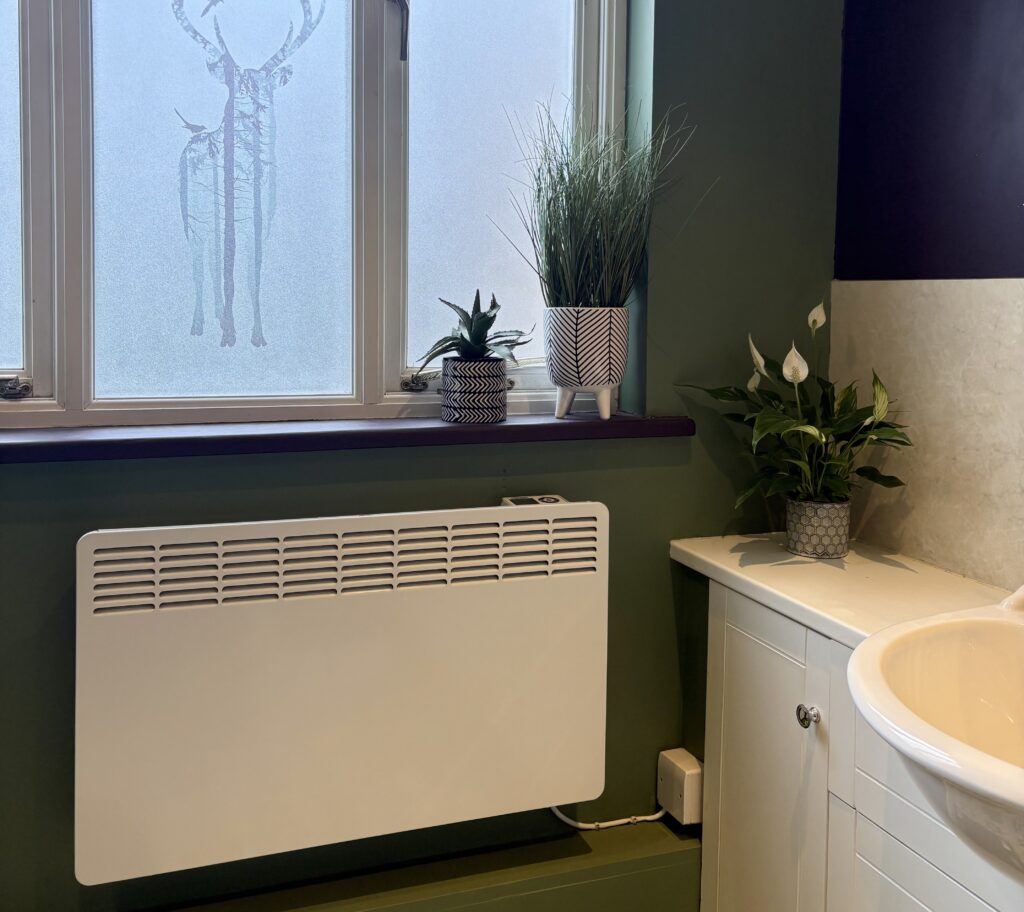
A Peace Lily in our bathroom with 2 artificial plants for decoration.
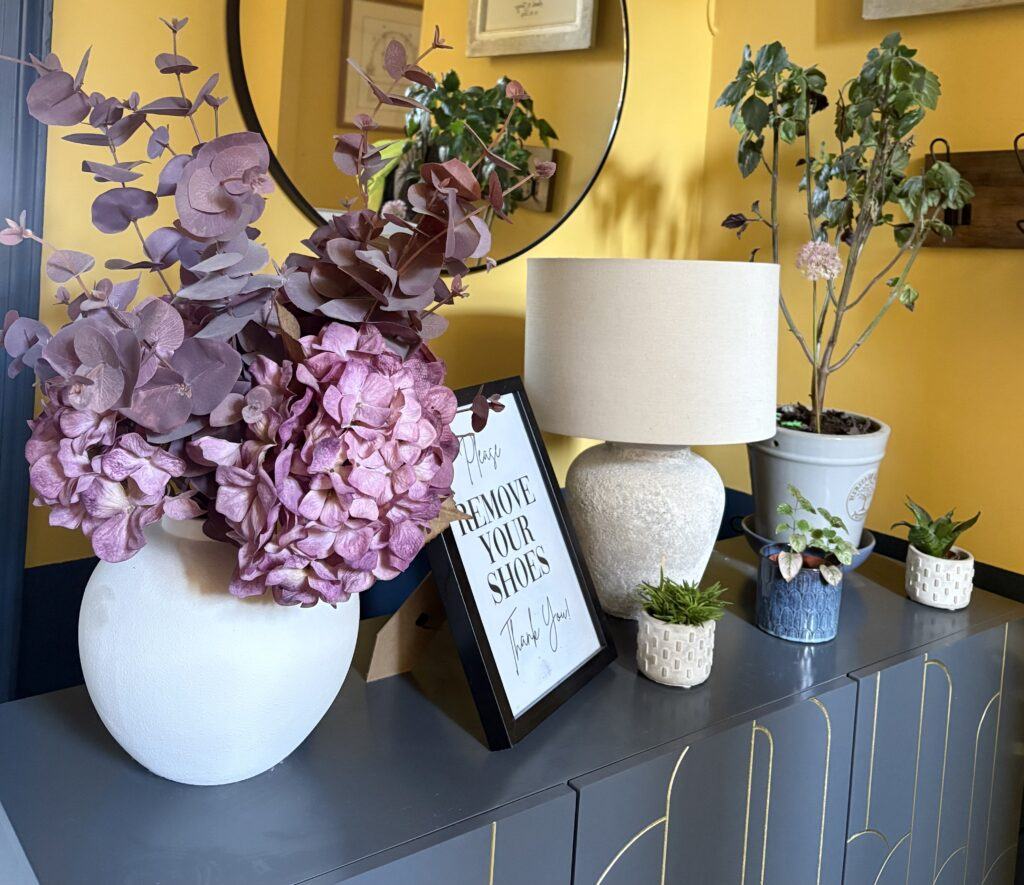
3 small indoor plants on our Hallway sideboard with artificial stems in a vase for decoration.

Hi Jenny, I found this to be a refreshing and helpful guide. I really liked how you shared your personal journey—from receiving an orchid to creating an indoor jungle. That kind of storytelling makes the post especially valuable for those new to indoor gardening. Your tips about placing plants near sunlight, grouping them for visual impact, and choosing the right types based on lifestyle were super practical. I also appreciated how you highlighted the benefits like air purification and stress reduction—it’s a great reminder that plants offer more than just beauty.
Quick question: Do you have a favorite go-to plant for beginners who want something low-maintenance but still visually striking?
Hi Mohamed, thank you so much for your kind words—I’m really glad you found the guide helpful! Sharing my own journey has been such a joy, especially knowing it encourages others who are just starting out.
As for a great beginner-friendly plant, my top recommendation would be the snake plant (Sansevieria). It’s incredibly low-maintenance, tolerates low light, and doesn’t mind if you forget to water it now and then. Plus, its tall, architectural leaves make a bold statement in any room. If you’d like something with a bit of trailing charm, the pothos is another favourite—it grows quickly, adapts well to different conditions, and looks beautiful cascading from a shelf or hanging pot.
Both are forgiving, stylish choices to kickstart your indoor garden!
This is actually very helpful for a guy like me, if it wasn’t for my wife we probably wouldn’t have any plants. I’ve never really had plants before, mostly because I’ll just kill them (Not on purpose). I like the idea of starting with something simple like a snake plant or pothos, but I get confused about light. How do you actually know if a corner in your room counts as ‘low light’ or if it’s just too dark for any plant at all?
I’m glad you found this helpful! You’re not alone—lots of people avoid plants because they’re worried about keeping them alive, but starting simple is a great approach.
A quick way to think about light is this: if you can comfortably read a book in that corner during the day without turning on a lamp, it usually counts as “low light” and plants like snake plants or pothos can manage. If you need to squint or always turn on artificial light, it’s probably too dark for even low-light plants to really thrive.
Another tip: notice how the space looks throughout the day. Corners that never get direct sun but still get a soft, ambient glow are perfect for low-light plants. If it feels more like a closet, that’s when a plant light can really help.
You’re definitely on the right track—starting with forgiving plants and learning how they respond will give you confidence for more variety later on!
As a stay-at-home mom, I’ve recently discovered the quiet joy of tending to indoor plants, and it has truly transformed my home and my mindset. It all started with a tiny pothos I picked up on a whim, and now I find myself rearranging shelves to give my plants the best light and space to thrive.
Your tips on grouping plants and selecting the right planters really resonated with me. I never realized how much personality a room could gain from a few leafy additions. Additionally, watching my kids grow up surrounded by greenery feels like a wonderful gift to their well-being.
Thank you for sharing your journey and all these thoughtful insights. I’m feeling inspired to try a hanging planter next… maybe in the kitchen!
This was such a lovely, inspiring read — thank you! I especially loved how you combine aesthetics and practicality: matching plants to light, using vertical space, picking stylish planters, etc. — things that feel doable in everyday life. The way you talk about grouping plants, playing with textures, and letting even just one plant transform a room really hit me. It reminds me that a home doesn’t need a jungle to feel alive — it just needs intention and a few green friends.